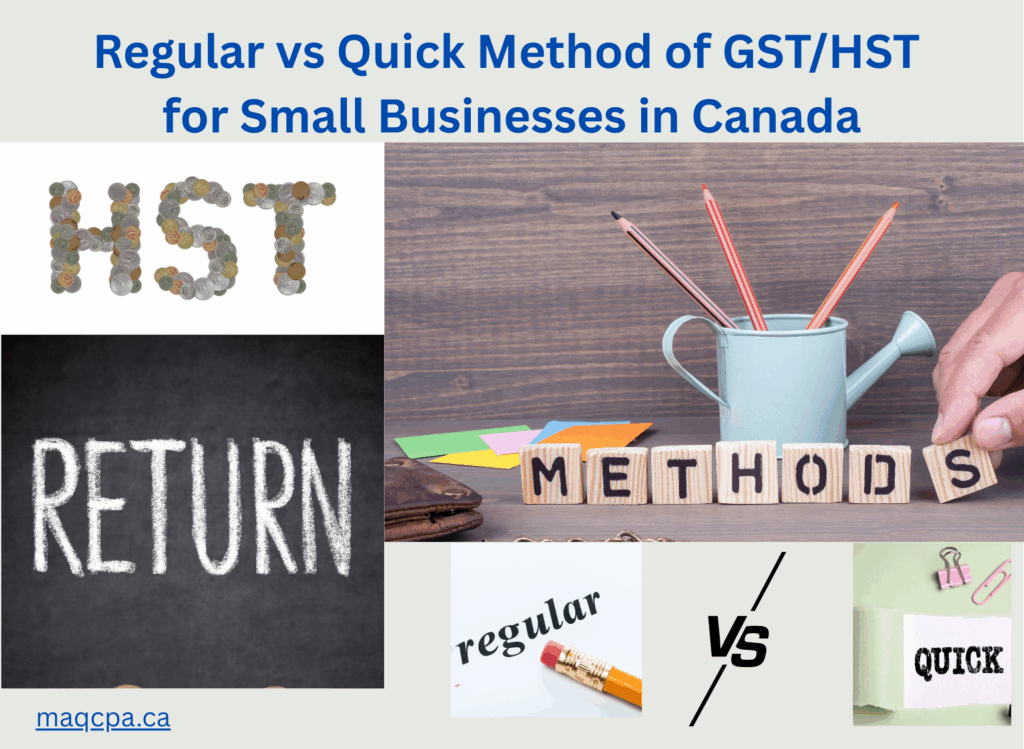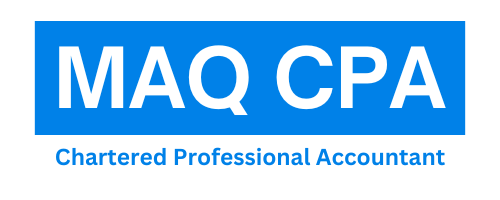Picking the right GST/HST accounting and reporting period is one of the fastest ways a Canadian small business can improve cash flow, reduce admin time, and stay audit-ready. Whether you operate in Toronto, Scarborough, Markham, Mississauga, Brampton, Vaughan, Richmond Hill, North York, Pickering, Ajax, Whitby, Oshawa, Oakville, Burlington, Hamilton or Canada, this guide explains regular vs quick method of GST/HST and shows who it’s best for, and gives you a practical way to decide.

GST/HST Basics for Small Businesses Canada
- When to register: Most businesses must register when worldwide taxable supplies exceed $30,000 in a single calendar quarter (or over the last four consecutive quarters).
- How net tax works:
Net tax = GST/HST collected on your taxable sales − Input Tax Credits (ITCs) on eligible business purchases. - E-filing is now the norm: For reporting periods beginning January 1, 2024 or later, most registrants must file electronically.
- Deadlines by reporting period:
- Monthly/Quarterly: return and payment due 1 month after the period ends.
- Annual: return due 3 months after fiscal year-end (you may need quarterly installments if last year’s net tax was $3,000+).
- Monthly/Quarterly: return and payment due 1 month after the period ends.
The GST/HST Reporting Methods (Small-Business Focus Only)
1) Regular Method of GST/HST Reporting
How it works: You charge GST/HST at the applicable rate on taxable sales, then claim ITCs for the actual GST/HST paid/payable on eligible purchases. You remit the difference.
Best for: Businesses with meaningful input tax (inventory, subcontractors, rent, utilities) or any business that prefers maximum precision and full ITC recovery.
Trade-offs: More tracking effort (you must separate ineligible amounts, mixed-use items, and apply timing rules for ITCs).
What to do next:
- Map your chart of accounts so purchases with GST/HST flow to eligible accounts.
- Create a month-end close (bank recs, sales tax exception report, ITC review).
- Keep supporting documents attached to each transaction (invoices/receipts).
2) Quick Method of GST/HST Reporting for Small Businesses
How it works: You still charge customers the normal GST/HST rate, but you remit a reduced “remittance rate” on your GST/HST-included sales instead of claiming most ITCs. You also get a 1% credit on the first $30,000 of eligible sales each fiscal year. You may still claim ITCs for certain capital items (e.g., equipment).
Who can use it (high level): Small businesses with worldwide taxable supplies of $400,000 or less (including GST/HST) can typically elect in—but several professions are excluded, such as firms primarily offering legal, accounting, bookkeeping, actuarial, or tax/financial consulting services.
Best for: Service-heavy businesses with low taxable inputs that want simplicity and potentially lower remittances than the Regular Method. Think: creative studios, cleaning services, trades with modest materials, independent coaches, and many solo consultants (except excluded professions).
Trade-offs: If your costs include significant input tax (e.g., inventory-heavy retailers/wholesalers), the Regular Method may beat the Quick Method. You must also monitor the $400k cap.
What to do next:
- Model the next 12 months: compare Regular (with real ITCs) vs Quick Method (remittance rate + 1% credit on first $30k).
- Confirm you’re not excluded by your primary business activity.
- If electing in, switch at a fiscal year start (or registration start) for clean reporting.
Reporting Periods (Pick What Matches Cash Flow & Admin Capacity)
- Annual if your annual taxable revenues are ≤ $1.5M (you may elect quarterly or monthly if you prefer).
- Quarterly if > $1.5M to ≤ $6M (you can elect monthly).
- Monthly if > $6M (mandatory).
Owner tip: If you expect refunds (e.g., inventory or equipment buys), monthly filing can speed up cash back. If admin capacity is tight but cash is predictable, quarterly can be a better option for many small businesses in Canada.
How to Choose between Regular vs Quick Method of GST/HST
- Input-tax profile:
- Low inputs (mostly labour/service) → Quick Method often wins.
- High inputs/inventory → Regular Method.
- Low inputs (mostly labour/service) → Quick Method often wins.
- Eligibility & exclusions: If you primarily provide legal, accounting, bookkeeping, actuarial, or tax/financial consulting, Quick Method is off the table—use Regular.
- Growth path: Near $400k in supplies? Weigh the friction of electing into Quick Method and exiting soon versus staying on Regular.
- Admin appetite: Short on time? The Quick Method (only if it’s beneficial) can remove a ton of receipt-by-receipt math for ITCs while keeping accuracy.
- Reporting period: If cash is tight or refunds are frequent, monthly helps. If you prefer fewer filings and stable remittances, quarterly or annually can fit.
Regular vs Quick GST/HST Method Examples
- Toronto design studio (service-heavy): Few taxable inputs beyond software and a small office, so modeled both methods and elected the Quick Method. With the 1% credit on the first $30,000 and the lower remittance rate, annual net remittance fell modestly and month-end bookkeeping got easier.
- Scarborough distributor (inventory heavy): Regular Method produced larger ITCs than the Quick Method credit. They kept the Regular Method.
- Markham home-services contractor (materials moderate): Modeled both. In low-material months, Quick looked better; across the full year with seasonal material purchases, Regular won. They file monthly to accelerate refunds during equipment buys.
- North York e-commerce business (scaling past $400k): Quick Method would only be a short-term win. They stayed Regular from day one and built a scalable close checklist to avoid method changes mid-growth.
Master Summary Table — Small-Business GST/HST Methods & Reporting
| # | Choice | How It Works | Best For | Key Trade-offs | What to Do Next (Solution) | Helpful Tools (Examples) |
| 1 | Regular Method | Charge normal GST/HST; claim actual ITCs; remit the difference | Input-heavy firms (retail/wholesale; trades with materials) | More tracking; must manage mixed-use, timing | Map accounts; build month-end close; attach docs to entries | QuickBooks Online / Xero; Dext/Hubdoc |
| 2 | Quick Method | Charge normal GST/HST; remit at reduced rate; 1% credit on first $30k; limited ITCs (capital allowed) | Service-heavy firms with low inputs and ≤ $400k supplies; not in excluded professions | If inputs are high, Regular may be cheaper; monitor cap | Model 12 months; confirm eligibility; elect at fiscal-year start | QBO/Xero (Quick settings); CRA My Business Account; spreadsheet |
| 4 | Reporting Period | Annual ≤ $1.5M, Quarterly > $1.5M–≤ $6M, Monthly > $6M; annual filers may owe instalments if net tax ≥ $3k | Choose for cash flow and admin | Monthly = more filings; annual = bigger year-end bill | Pick a cadence that matches cash; set calendar + reminders | CRA My Business Account; banking for scheduled payments |
FAQs – Regular vs Quick Method of GST/HST Accounting
1) Which method saves my small business the most money?
Run a 12-month model. If your costs have low GST/HST, the Quick Method can reduce remittances and admin. If you buy inventory/materials regularly, the Regular Method often produces higher ITCs and a lower net.
2) I’m a professional services firm—can I use the Quick Method?
If your primary activity is legal, accounting, bookkeeping, actuarial, or tax/financial consulting, you’re generally excluded from the Quick Method.
3) How does the 1% credit under the Quick Method work?
Each fiscal year, reduce your remittance by 1% of the first $30,000 of eligible GST/HST-included sales (while your Quick Method election is in effect). Track when you hit the $30k threshold.
4) We sell in both Ontario (13% HST) and Alberta (5% GST). Can we use one Quick Method rate?
Often no. Apply the correct remittance rate for sales tied to each province/establishment unless 90%+ of your eligible sales are in one rate zone.
5) What records do I need if I use the Quick Method?
The method simplifies the math, not the records. Keep full books and receipts, support sales totals by region, and keep documents for any capital ITCs you claim.
6) What’s the easiest way to use the Regular Method without drowning in paperwork?
Adopt the Simplified ITC approach. Use the fractions on totals, exclude ineligible items, and keep a worksheet with your calculation each period.
7) Should I file monthly, quarterly, or annually?
- Expect refunds or buy inventory/equipment regularly? Monthly can speed cash back.
- Prefer fewer filings and stable payments? Quarterly may fit better.
- Annual is simplest, but plan for a bigger year-end payment and possible instalments next year if your net tax is high.
8) Is e-filing mandatory for small businesses now?
For reporting periods starting 2024 or later, most registrants must file electronically. Make sure your CRA My Business Account access is set up.
9) Can I switch methods during the year?
The Quick Method election generally takes effect at the start of a fiscal year (or when you first register). Plan changes for year-end to avoid messy mid-year splits.
10) We’re close to the $400k Quick Method cap—what should we do?
If you expect to exceed $400k soon, consider staying with the Regular Method to avoid switching into Quick and back out shortly after.
Consult a Business Tax Accountant Toronto/Markham
The best GST/HST setup is mathematical, not mystical: match your inputs to the right method, match your cash flow to the right reporting period, and lock in a repeatable close so filing is fast and defensible.
Schedule a consultation for GST/HST Method Review with our business tax accountant Toronto/Scarborough. We’ll model Regular vs Quick, align your reporting preference, and build a checklist so tax time stops taking your valuable time.
Disclaimer
The information provided in this blog is for general informational purposes only and does not constitute professional accounting, tax, financial, or legal advice. While we strive to ensure the accuracy and timeliness of the content, the information may not apply to your specific situation or reflect the most current legislative changes. Readers are strongly advised to consult a qualified legal or tax professional before making any decisions based on the content of this blog. MAQ CPA and its representatives disclaim any liability for any loss or damage incurred as a result of reliance on any information provided herein.
